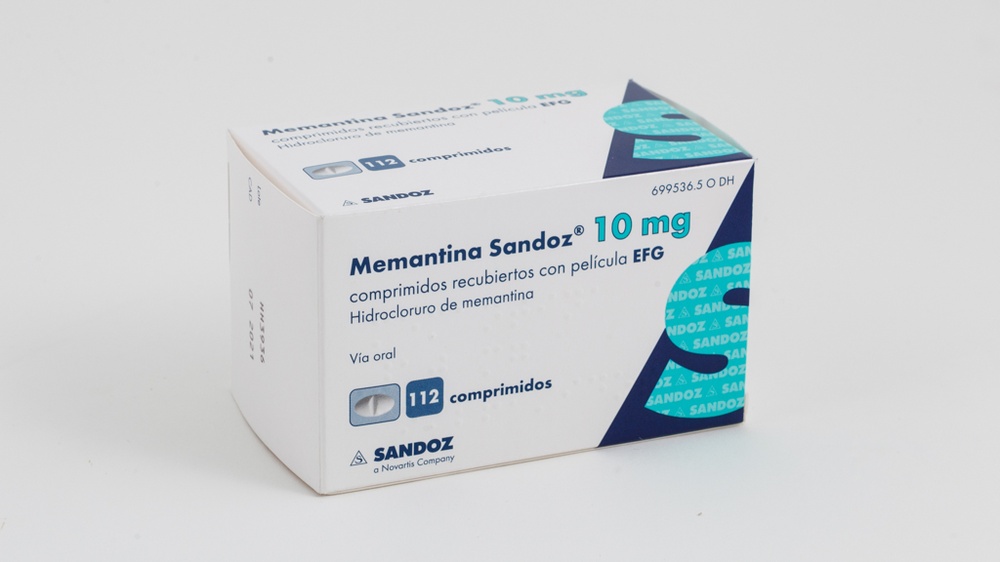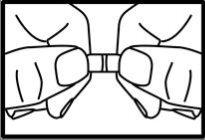

MEMANTINE SANDOZ 10 mg FILM-COATED TABLETS

Ask a doctor about a prescription for MEMANTINE SANDOZ 10 mg FILM-COATED TABLETS

How to use MEMANTINE SANDOZ 10 mg FILM-COATED TABLETS
Introduction
Package Leaflet: Information for the Patient
Memantina Sandoz 10 mg Film-Coated Tablets EFG
memantine, hydrochloride
Read all of this leaflet carefully before you start taking this medicine because it contains important information for you.
- Keep this leaflet, you may need to read it again.
- If you have any further questions, ask your doctor or pharmacist.
- This medicine has been prescribed for you only. Do not pass it on to others. It may harm them, even if their signs of illness are the same as yours.
- If you get any side effects, talk to your doctor or pharmacist. This includes any possible side effects not listed in this leaflet. See section 4.
Contents of the pack
- What is Memantina Sandoz and what is it used for
- What you need to know before you take Memantina Sandoz
- How to take Memantina Sandoz
- Possible side effects
- Storage of Memantina Sandoz
- Contents of the pack and other information
1. What is Memantina Sandoz and what is it used for
How Memantina Sandoz works
Memantine belongs to a group of medicines called anti-dementia medicines.
Memory loss in Alzheimer's disease is due to an alteration in brain signals. The brain contains so-called N-methyl-D-aspartate (NMDA) receptors that are involved in the transmission of important nerve signals in learning and memory. Memantine belongs to a group of medicines called NMDA receptor antagonists. Memantine acts on these receptors, improving the transmission of nerve signals and memory.
What Memantina Sandoz is used for
Memantine is used in the treatment of patients with moderate to severe Alzheimer's disease.
2. What you need to know before you take Memantina Sandoz
Do not takeMemantina Sandoz
- if you are allergic to memantine hydrochloride or any of the other ingredients of this medicine (listed in section 6).
Warnings and precautions
Consult your doctor or pharmacist before starting to take Memantina Sandoz:
- if you have a history of epileptic seizures,
- if you have recently suffered a myocardial infarction (heart attack), or if you suffer from congestive heart failure or uncontrolled hypertension (high blood pressure).
In these situations, treatment should be carefully supervised and your doctor should regularly re-evaluate the clinical benefit of memantine.
If you have kidney problems, your doctor should closely monitor your kidney function and, if necessary, adjust the dose of memantine.
The use of memantine with other medicines such as amantadine (for the treatment of Parkinson's disease), ketamine (a medicine generally used to produce anesthesia), dextromethorphan (a medicine for the treatment of cough), and other NMDA antagonists should be avoided.
Children and adolescents
The use of memantine in children and adolescents under 18 years of age is not recommended.
Taking Memantina Sandoz withother medicines
Tell your doctor or pharmacist if you are taking, have recently taken, or might take any other medicines.
In particular, the administration of Memantina Sandoz may produce changes in the effects of the following medicines, so your doctor may need to adjust the doses:
- amantadine, ketamine, dextromethorphan,
- dantrolene, baclofen,
- cimetidine, ranitidine, procainamide, quinidine, quinine, nicotine,
- hydrochlorothiazide (or any combination with hydrochlorothiazide),
- anticholinergics (substances generally used to treat movement disorders or intestinal spasms),
- anticonvulsants (substances used to prevent and eliminate convulsions),
- barbiturates (substances generally used to induce sleep),
- dopaminergic agonists (substances such as L-dopa, bromocriptine),
- neuroleptics (substances used in the treatment of mental illnesses),
- oral anticoagulants.
If you are hospitalized, inform your doctor that you are taking Memantina Sandoz.
Taking Memantina Sandoz with food and drinks
You should inform your doctor if you have recently changed or intend to change your diet substantially (e.g., from a normal diet to a strict vegetarian diet) or if you have renal tubular acidosis (RTA, excess of acid-producing substances in the blood due to kidney dysfunction) or severe urinary tract infections (urinary tract), as your doctor may need to adjust the dose of the medicine.
Pregnancy, breastfeeding, and fertility
If you are pregnant or breastfeeding, think you may be pregnant, or are planning to have a baby, ask your doctor or pharmacist for advice before taking this medicine.
Pregnancy
Memantine is not recommendedfor use in pregnant women.
Breastfeeding
Women taking memantine should stop breastfeeding.
Driving and using machines
Your doctor will inform you if your illness allows you to drive and use machines safely.
Also, memantine may alter your reaction ability, so driving or operating machinery may be inappropriate.
Memantina Sandoz contains lactose
This medicine contains lactose. If your doctor has told you that you have an intolerance to some sugars, consult them before taking this medicine.
3. How to take Memantina Sandoz
Follow exactly the administration instructions of this medicine given by your doctor or pharmacist. In case of doubt, consult your doctor or pharmacist again.
Posology
The recommended doseof memantine in adult and elderly patients is 20 mg administered once a day. To reduce the risk of side effects, this dose is gradually achieved following the following daily scheme:
Treatment period | Daily dose |
week 1 | half a 10 mg tablet |
week 2 | one 10 mg tablet |
week 3 | one and a half 10 mg tablets |
week 4 and onwards | two 10 mg tablets |
Dosage for patients with renal impairment
If you have kidney problems, your doctor will decide the appropriate dose for your condition. In this case, your doctor should periodically monitor your kidney function.
Administration
Memantine should be administered orally once a day. To get the most out of your medication, you should take it every day and at the same time. The tablets should be swallowed with a little water. The tablets can be taken with or without food.
The tablets can be divided into two equal doses, as described in the drawing. If necessary, take the tablet and press with your thumbs on the index fingers.

Duration of treatment
Continue taking memantine as long as it is beneficial for you. The doctor should periodically evaluate the effects of your treatment.
If you take more Memantina Sandozthan you should
In case of overdose or accidental ingestion, consult your doctor or pharmacist immediately or call the Toxicology Information Service, phone: 91 562 04 20, indicating the medicine and the amount ingested.
Generally, taking an excessive amount of memantine should not cause you any harm. You may experience an increase in the symptoms described in section 4 "Possible side effects".
If you forget to takeMemantinaSandoz
- If you realize that you have forgotten to take your dose of memantine, wait and take the next dose at the usual time.
- Do not take a double dose to make up for forgotten doses.
If you have any other questions about the use of this medicine, ask your doctor or pharmacist.
4. Possible side effects
Like all medicines, this medicine can cause side effects, although not everybody gets them.
Generally, the side effects are mild to moderate.
Common,may affect up to 1 in 10 people:
- headache, drowsiness, constipation, elevated liver function tests, dizziness, balance disorder, shortness of breath, high blood pressure, and hypersensitivity to the medicine.
Uncommon,may affect up to 1 in 100 people:
- fatigue, fungal infections, confusion, hallucinations, vomiting, gait disturbance, heart failure, and venous thrombosis/thromboembolism.
Rare,may affect up to 1 in 10,000 people:
- seizures.
Frequency not known,the frequency cannot be estimated from the available data:
- pancreatitis, hepatitis, and psychotic reactions.
Alzheimer's disease has been associated with depression, suicidal ideation, and suicide. These events have been reported in patients treated with this medicine.
Reporting of side effects
If you experience any side effects, talk to your doctor or pharmacist. This includes any possible side effects not listed in this leaflet. You can also report side effects directly through the national reporting system: Spanish Medicines Surveillance System for Human Use: https://www.notificaram.es.
By reporting side effects, you can help provide more information on the safety of this medicine.
5. Storage of Memantina Sandoz
Keep this medicine out of the sight and reach of children.
This medicine does not require any special storage conditions.
Do not use this medicine after the expiry date which is stated on the blister or label and carton after EXP. The expiry date is the last day of the month stated.
After first opening, use the contents of the bottle within 6 months.
Medicines should not be disposed of via wastewater or household waste. Ask your pharmacist how to dispose of medicines no longer required. These measures will help protect the environment.
6. Contents of the pack and other information
Composition of Memantina Sandoz
- The active substance is memantine. Each tablet contains 10 mg of memantine hydrochloride equivalent to 8.31 mg of memantine.
- The other ingredients are lactose monohydrate, microcrystalline cellulose, anhydrous colloidal silica, and magnesium stearate in the core; hypromellose (E 464), lactose monohydrate, macrogol, triacetin, and titanium dioxide (E 171) in the coating.
Appearance of the product and contents of the pack
White, oval (6.1 x 11.6 mm) film-coated tablets with a score line on both sides.
The film-coated tablets can be divided into two equal doses.
The film-coated tablets are packaged in transparent PVC-Aclar/Aluminum and/or transparent PVC-PVDC/Aluminum blisters or in HDPE bottles with a screw cap of PP with a safety closure and desiccant inserted in a cardboard box.
Pack sizes:
Blister: 7, 10, 14, 18, 20, 22, 28, 30, 40, 42, 45, 48, 49, 49x1, 50, 56, 56x1, 60, 70, 84, 90, 96, 98, 98x1, 100, 100x1, 112, 980 (10x98) or 1000 (20x50) film-coated tablets.
Bottle: 28, 30, 56, 98, 100 or 112 film-coated tablets.
Not all pack sizes may be marketed.
Marketing authorization holder and manufacturer
Marketing authorization holder
Sandoz Farmacéutica, S.A.
Centro Empresarial Parque Norte
Edificio Roble
C/ Serrano Galvache, 56
28033 Madrid
Spain
Manufacturer
Lek Pharmaceuticals d.d.
Verovškova 57,
1526 Ljubljana
Slovenia
or
Lek S.A.
ul. Domaniewska 50 C,
02-672 Warszawa
Poland
or
Salutas Pharma GmbH
Otto-von-Guericke-Allee 1,
39179
Barleben
Germany
or
S.C. Sandoz, S.R.L.
Str. Livezeni nr. 7A,
RO-540472 Targu-Mures
Romania
This medicine is authorized in the Member States of the European Economic Area under the following names:
Netherlands:Memantine Sandoz 10 mg, film-coated tablets
Austria:Memantin Sandoz 10 mg - Filmtabletten
Belgium:Memantine Sandoz 10 mg film-coated tablets
Czech Republic:Memantin Sandoz 10 mg
Greece:Memantine/Sandoz
Finland:Memantine Sandoz 10 mg tablets, film-coated
France:Memantine Sandoz 10 mg, scored film-coated tablets
Portugal:Memantina Sandoz
Sweden:Memantine Sandoz
United Kingdom:Memantine 10 mg Film-coated Tablets
Date of last revision of this leaflet: May 2020
Detailed and updated information on this medicine is available on the website of the Spanish Agency for Medicines and Health Products (AEMPS) http://www.aemps.gob.es/
- Country of registration
- Active substance
- Prescription requiredYes
- Manufacturer
- This information is for reference only and does not constitute medical advice. Always consult a licensed doctor before taking any medication. Oladoctor is not responsible for medical decisions based on this content.
- Alternatives to MEMANTINE SANDOZ 10 mg FILM-COATED TABLETSDosage form: TABLET, 10 mgActive substance: memantineManufacturer: Merz Pharmaceuticals GmbhPrescription requiredDosage form: TABLET, 10 mgActive substance: memantineManufacturer: Merz Pharmaceuticals GmbhPrescription requiredDosage form: TABLET, 20 mgActive substance: memantineManufacturer: Merz Pharmaceuticals GmbhPrescription required
Alternatives to MEMANTINE SANDOZ 10 mg FILM-COATED TABLETS in other countries
The best alternatives with the same active ingredient and therapeutic effect.
Alternative to MEMANTINE SANDOZ 10 mg FILM-COATED TABLETS in Poland
Alternative to MEMANTINE SANDOZ 10 mg FILM-COATED TABLETS in Ukraine
Online doctors for MEMANTINE SANDOZ 10 mg FILM-COATED TABLETS
Discuss dosage, side effects, interactions, contraindications, and prescription renewal for MEMANTINE SANDOZ 10 mg FILM-COATED TABLETS – subject to medical assessment and local rules.












